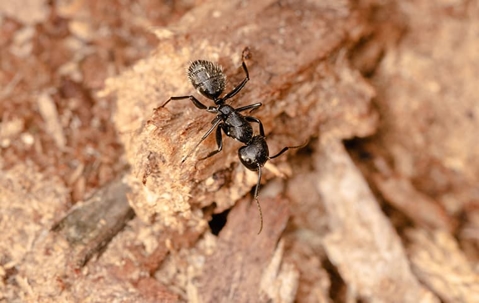Ants are common home invaders, but certain species pose more risk than others, and carpenter ants are at the top of the list. These ants are typically easily recognizable, being larger than other species. But, because they build their nests inside wood and are more likely to forage at night, you may not notice the ants themselves.
This Step-by-Step guide will provide the information you need to achieve successful control of carpenter ants in New Jersey. We’ll review the risks they pose, describe the signs of their activity, and provide prevention strategies to keep them out of the house. Continue reading to learn more about carpenter ant control, including when to call in the pros with Heritage Pest.
Step One: Understand The Risks Associated With Carpenter Ants
Unlike termites, which consume the wood they infest, carpenter ants use their powerful jaws to excavate the wood to create smooth nesting galleries. At maturity, carpenter ant colonies average between 10,000 and 20,000 individual ants, with larger colonies having up to 50,000 insects. Carpenter ants usually start in wood with water damage or mold but eventually move on to dry, undamaged wood.
Generally, these ants are considered less destructive than termites, but over time, if a carpenter ant infestation goes unnoticed, it can weaken your home’s structural integrity. If you suspect these ants are in your home, the sooner you take action, the better. Contact us today at Heritage Pest to learn more about our carpenter ant control services.
Step Two: Recognizing Carpenter Ant Infestations In The Home
Carpenter ants are between 1/2 and 5/8 of an inch long and are usually black, but they can also be brown, red, or a combination of red and black. The following list describes the signs of carpenter ants in your house to watch for:
- A single carpenter ant in the home can indicate an infestation.
Winged males in the house signify they are living inside.
A rustling sound in wall voids or wood when the winged ants are disturbed.
Small holes in wood surfaces with piles of sawdust below.
If you need assistance identifying or getting rid of carpenter ants in your house, Heritage Pest is here to help. Contact us today to learn more about our carpenter ant control options or to request your service.
Step Three: Seeking Professional Help
Because these pests can cause structural damage to your home, professional carpenter ant treatments are the safest and most effective option. Since 1989, Heritage Pest has been helping our neighbors protect their homes from destructive pests like carpenter ants. Contact us today to learn more about how our residential pest control services can eliminate problem pests and protect your home from future infestations.
Step Four: Prevention Strategies To Keep Carpenter Ants At Bay
Prevention is the key to ongoing carpenter ant pest control. Here are some effective strategies you can use to deter these pests in the future:
- Promptly deal with any moisture problems, such as leaking pipes, faucets, or areas on your property with standing water.
Remove and replace any wood that has water damage.
Seal cracks and gaps on the exterior using silicone caulk or steel wool.
Regularly trim tree branches and bushes back away from the house.
Store firewood and building materials at least 20 feet from the structure.
Combining your efforts with professional ongoing pest control services is the most effective way to keep these pests at bay. Contact us today at Heritage Pest to learn more about preventative residential pest control options or to request your service.

